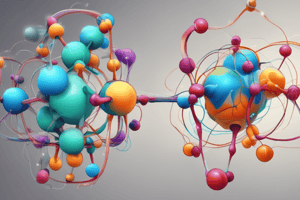Podcast
Questions and Answers
In the molecule H2S, which atom would have a partial negative charge?
In the molecule H2S, which atom would have a partial negative charge?
- Both H and S
- H
- Neither H nor S
- S (correct)
Which of the following molecules would be considered polar?
Which of the following molecules would be considered polar?
- N2
- H2S (correct)
- CCl4
- None of the above
What is the main reason why elements tend to form ions?
What is the main reason why elements tend to form ions?
- To increase their atomic radius
- To become more reactive
- To achieve a stable electron configuration (correct)
- To decrease their ionization energy
Which of the following statements is TRUE regarding the octet rule?
Which of the following statements is TRUE regarding the octet rule?
Which of the following elements is most likely to form a cation?
Which of the following elements is most likely to form a cation?
What type of bond is formed when electrons are transferred from a cation to an anion?
What type of bond is formed when electrons are transferred from a cation to an anion?
In which type of bond do two nonmetals share electrons?
In which type of bond do two nonmetals share electrons?
What is the relationship between electronegativity and the type of bond formed?
What is the relationship between electronegativity and the type of bond formed?
Which of the following bonds is typically weaker and involves equal electron sharing?
Which of the following bonds is typically weaker and involves equal electron sharing?
Which of the following pairs of atoms is most likely to form an ionic bond?
Which of the following pairs of atoms is most likely to form an ionic bond?
Flashcards are hidden until you start studying
Study Notes
Types of Bonds
- Chemical bonds are forces that hold atoms together in molecules or compounds.
- Bonds can be classified into Ionic and Covalent bonds.
Ionic Bonds
- Formed by the electrostatic attraction between oppositely charged ions (cation and anion).
- Involves the transfer of electrons from metals (cation) to nonmetals (anion).
- Ionic bonds are extremely strong compared to covalent bonds.
- Occurs as a result of opposite charges attracting each other.
Covalent Bonds
- Created by the sharing of electrons between nonmetal atoms.
- Typically result in a neutral overall charge due to equal electron sharing.
- Weaker than ionic bonds; electrons are usually shared in pairs.
- Can be further classified into:
- Nonpolar Covalent Bonds: No difference in electronegativity.
- Polar Covalent Bonds: A difference in electronegativity exists.
Electronegativity
- Defined as the ability of an atom to attract bonding electrons.
- Greater electronegativity difference leads to increased ionic character; results in more polar bonds.
- Polar bonds generally have shorter, stronger bonds while nonpolar bonds are longer and weaker.
Ionic Bonding
- Main-group elements tend to lose or gain electrons to achieve an electron configuration isoelectronic with noble gases.
- Metals (elements following noble gases) have low electronegativities and tend to lose electrons, forming positive cations.
- Nonmetals (elements preceding noble gases) have high electronegativities, gaining electrons to form negative anions.
- The electron configuration of elements plays a significant role in the formation of ions and ionic bonds.
Electron Dot Symbol and Octet Rule
- Electron dot symbols illustrate valence electrons around an element's symbol, distributed around four sides, pairing as needed.
- The Octet Rule states that atoms tend to achieve an electron configuration with eight valence electrons, similar to that of noble gases.
Studying That Suits You
Use AI to generate personalized quizzes and flashcards to suit your learning preferences.




